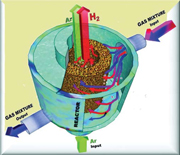Preparation, Characterization and Gas Permeation Investigation of Resorcinol-Formaldehyde Polymer or Carbon Xerogels/Tubular Ceramic Composites
Keywords:
Composite materials, xerogel, sol-gel process, porous ceramics, gas permeationAbstract
New very stable composites prepared by deposition of resorcinol-formaldehyde polymer (RF-) or carbon (C-) xerogels into walls of commercial porous tubular ceramics (TiO2-ZrO2 and alphaAl2O3-gammaAl203) were obtained by a sol-gel process followed by a drying and a pyrolytic (only for C-xerogel/ceramic composites) step. They were characterized by nitrogen adsorption-desorption, SEM and XRD, and tested for gas (H2, CH4, CO2 and CO) separation applications. Additional morpho-structural information about the open-interconnected ultramicropore structure of composites was found by gas permeation investigation. Interesting results for H2 permeance was obtained especially for RF-polymer/ceramic composites respecting Knudsen diffusion mechanism of gas permeance: H2 > CH4 > CO > CO2. The coexistence of Knudsen and surface diffusion mechanisms were confirmed.

Downloads
Published
Issue
Section
License
Except where otherwise noted, articles in this journal are published under the Creative Commons Attribution 4.0 International License
